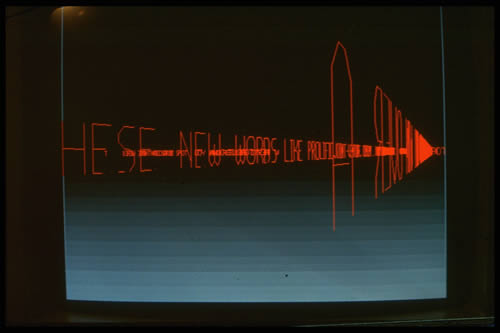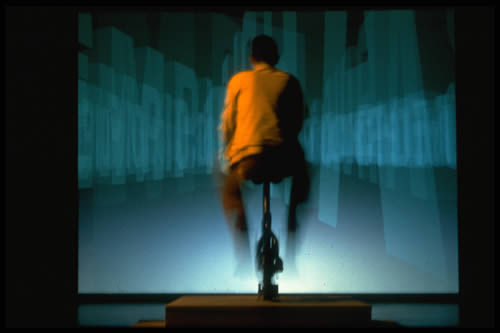Lisa Swanstrom
Related Categories: New Reading Interfaces, Art Installations
Summary:
Jeffrey Shaw’s “Legible City” is an interactive art installation that requires active, physical participation of its viewers. To make the installation function, a “rider” sits on a stationery bicycle, pedals, and navigates through simulated city streets and architectural structures made of letters, words, and sentences that are projected on a large screen. In this manner, the viewer both rides and reads as she navigates through this text-based virtual space. Requiring as it does the active, embodied participation of the reader/rider, Shaw’s “Legible City” provides a very interesting, very visible expression and enactment of reading as a fully embodied and physical activity in which the human body is well integrated into its surrounding environment.
Description:
First conceived of in 1988, “Legible City” has seen three iterations that have evolved over a ten-year period of time. The first is the “Legible City Prototype,” which debuted in 1988 as a set of “wire-frame graphics” displayed on a large computer screen. This iteration of the project presents the user with a long string of text that she can move and manipulate across a screen by using a joystick.
 Image of the 1988 prototype from the artist’s web site.
Image of the 1988 prototype from the artist’s web site.
The second iteration of “Legible City” requires a fuller physical commitment from the viewer. In this phase of the City, the joystick is supplanted as the tool of control and navigation and replaced by the stationary bicycle. In this installation, the viewer sits on a stationary bicycle that is positioned before a large screen. As the user begins to pedal the bicycle, letters begin to move across the screen, coalescing simultaneously into words, phrases, and sentences, as well as city streets, buildings, and other architectural structures. As the user rides–and reads–her way through this interactive, text-based cityscape, she is able to choose different routes to lead her around town and to approach the different pathways and structures from various perspectives in this virtual city space.
 Image of the 1988 prototype from the artist’s web site.
Image of the 1988 prototype from the artist’s web site.
The artist’s description of the project provides an excellent “nuts-and-bolts” summary:
In The Legible City the visitor is able to ride a stationary bicycle through a simulated representation of a city that is constituted by computer-generated three-dimensional letters that form words and sentences along the sides of the streets. Using the ground plans of actual cities – Manhattan, Amsterdam and Karlsruhe – the existing architecture of these cities is completely replaced by textual formations written…Traveling through these cities of words is consequently a journey of reading; choosing the path one takes is a choice of texts as well as their spontaneous juxtapositions and conjunctions of meaning.The handlebar and pedals of the interface bicycle give the viewer interactive control over direction and speed of travel. The physical effort of cycling in the real world is gratuitously transposed into the virtual environment, affirming a conjunction of the active body in the virtual domain. A video projector is used to project the computer-generated image onto a large screen. Another small monitor screen in front of the bicycle shows a simple ground plan of each city, with an indicator showing the momentary position of the cyclist. (From the artist’s web site: (http://www.jeffrey-shaw.net/html_main/frameset-works.php3)
In the final phase of the project, “Distributed Legible City,” (1998) multiple, bicycle-riding users enter the city from different locations and are able to encounter each other–either on purpose or by happenstance–while they read, ride create the “text.”
Research Context:
While “The Legible City” is something of an anomaly in its playful use of exercise equipment as a tool for artistic representation, it nevertheless fits extremely well within the study of reading practices in both the history of reading and in contemporary culture, especially in terms of the discourse surrounding the role of the body in apprehending text.
While “Legible City” is clearly an art object, it at the same time offers a potential conceptual and pedagogical tool to consider the tactile and kinesthetic senses in reading practices as much the visual. As Mark B.N. Hansen writes in his chapter on Jeffrey Shaw’s work in his book New Philosophy for New Media:
In these [Shaw’s computer-aided works] works, the body, rather than being assimilated into the deframed image-space, stands over against a now virtualized image-space, and thereby acquires a more fundamental role as the source of the actualizaiton of images. If the corporeal and intellectual processing it performs still functions to “give body” to the image, it does so not by lending its physical, extended volume as a three-dimensional screen for the image but rather by creating an image-event out of its own embodied processing of information.
In this sense, the project resonates very well with the research that artists and theorists such as Anne Balsamo have done in conjunction with Xerox Park’s RED team (the Research in Experimental Documents team), who have insisted upon the full body’s prominence as a site of apprehension and reading. As Anne Balsamo herself said at last year’s Transliteracies Conference:
What happens when you have documents that could never be accommodated by a handheld device?...Looking at the role of the body and the role of the body in technology—and how technologies are mediated through embodied experience—and so on—we talked a great deal about how the whole body, and not just the eyes and the hands, [is] a reading apparatus… (Transliteracies Conference, June 2005)
Insofar as Jeffrey Shaw’s “Legible City” engages with these same types of questions, I see it as being well situated in this discourse.
Technological Specifications:
While the three evolutions of the project are significantly distinct from each other, they all depend upon the following technologies: a database of word images, a screen to display them, and some type of hardware interface that allows a user to access and manipulate them.
In the first iteration of the Legible City, the project depends upon interaction between a user, a joystick, a computer screen, and a database filled with strings of text, which the user manipulates through moving the joystick. It is unclear from the project description which programming languages were employed to create this work.
The second phase of the Legible City has a larger screen–and a much more demanding physical interface: a stationary bicycle. As the rider pedals through the text, the screen pulls word-images from a database and displays them on the screen. In contrast to the prototype, this version makes use of “more advanced computer visualization methods”–although what these specific methods are is unclear.
The third and final iteration of the project, the “Distributed Legible City,” allows multiple “readers” to engage with the text–and with each other:
In the Distributed Legible City there are two or more bicyclists at remote locations who are simultaneously present in the virtual environment. They can meet each other (by accident or intentionally), see abstracted avatar representations of each other, and when they come close to each other they can verbally communicate with each other.
While the precise technological specifications for the Distributed Legible City are not explicitly delineated, based on the name “distributed,” it is possible to infer that the project makes use of a distributed network system in which each cyclist functions as one nodal point of a communication constellation.
Evaluation of Opportunities/Limitations for the Transliteracies Topic:
Shaw’s “Legible City” is of interest to the Transliteracies Project as an artistic expression and enactment of reading practice, as well as a way to imagine reading as a fully embodied, social, and shared experience in which the text is literally configured through the readers’ physical interaction with it–as well as with other readers. Since one of the Transliteracies’ most urgent goals is to improve reading online–reading which, like the reading done in “Legible City,” is a process that involves shared access to and shared authorship of a distributed network of information that affords multiple points of access (i.e., the Internet)–an in-depth analysis of Shaw’s project in all of its iterations may be of some use in achieving this goal.
Additionally, it may be fruitful to consider the pathways that the rider takes in the Legible City as a very physical representation of–or metaphor for–textual analysis, in that the reader moves through the text, makes choices about it, and actually shapes and creates the “meaning” of the text as a result of her action. Quite simply stated, the text of the “Legible City” is created by the actions and decisions of the embodied reader moving through it. As a pedagogical tool for helping to explain the creative aspects of textual analysis–frequently viewed by undergraduates as a difficult concept to grasp–the “Legible City” may prove very effective learning tools.
Finally, in terms of critical approaches to studying new media objects, this object, boldly removing as it does letters from the printed page and repositioning them within a computer-generated landscape, functions like the sequence in the film Shrek that N. Katherine Hayles emphasizes in Writing Machines, in that it … “illustrates that which Richard Grusin and Jay Bolter have called REMEDIATION, the cycling of different MEDIA through one another” (Writing Machines), or, to use their words, the “formal logic by which new media refashion prior media forms” (Remediation). By viewing the act of reading as a (re)mediated activity, we may be able to explore the ways that reading can be imagined beyond the printed page.
Resources for Further Study:
- Bolter, Jay and Richard Grusin. Remediation. Cambridge, Mass: MIT Press, 1999.
- Hansen, Mark B.N. New Philosophy for New Media. Cambridge, Mass: MIT Press, 2004.
- Hayles, N. Katherine. Writing Machines, designer Anne Burdick. Mediawork Series. Cambridge, Mass: MIT Press 2002.
- Shaw, Jeffrey. “The Legible City.” 1989.

March 27th, 2012 at 6:59 am
[...] related to online reading. The Internet Archive “esc for escape” Google Print Inform.com “The Legible City” Sony Reader “Reading as [...]